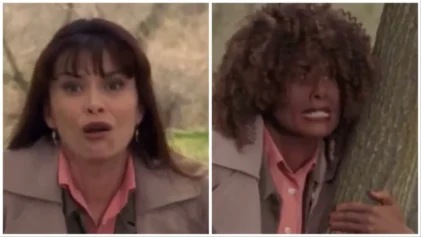High-fashion magazine VOGUE is under fire for its March 2014 issue featuring a spread with Dutch model Saskia de Brauw in blackface.
The Italian division of the magazine is the most recent to erupt controversy, but it isn’t the first. In 2013, VOGUE Netherlands ran “Heritage Heroes,” an intended nod to iconic Black women who inspired designer Marc Jacobs. That spread showed images of model Querelle Jansen in blackface, donning textured wigs to pay homage to Josephine Baker and Grace Jones. In 2009, French VOGUE photographed model Lara Stone covered in black paint for its supermodel issue.
The VOGUE Italia spread shot by photographer Steven Meise, according to the Huffington Post, depicts Brauw in jungle scenes wearing tattered tribal printed clothing, surrounded by wild animals, her naturally pale skin plastered in dark paint.
One photograph brought to mind the lyrics of Strange Fruit, in which writer Abel Meeropol musically recreates the lynching scene of Blacks in the “gallant South,” describing their “bulging eyes and twisted mouths.”
Meeropol was a Jewish man who told the Black story from his vantage point. The problem with blackface is whites are falsely assuming our vantage point to tell our story, which perpetuates their dominant narrative.
Many argue that these international fashion spreads are art and should not be considered offensive. They should be taken at face value especially since the history in other countries is not reflective of the cultural understandings inclusive of global readership.
Others would say knowledge of history in any context solidifies the cultural insensitivity that comes when one “race” depicts another.
The U.S. fashion website Jezebel responded to the 2009 French VOGUE spread photographed by Steven Klein and styled by editor Carine Roitfeld, saying,”What Klein and Roitfeld should know … is that painting white people black for the entertainment of other white people is offensive in ways that stand entirely apart from cultural context.
“France and Australia may not have the United States’ particular history of minstrel shows … but something about the act of portraying a white woman as black ought to sound an alarm, somewhere.”
Here it is 2014 and we are thrown into the same conversation we entertained five years ago- and have been entertaining since the mid-1800’s when minstrel shows touting white men in blackface were prominent fixtures on the entertainment circuits.
This type of spread strikes a chord with the Black American audience because we live in a country that rarely acknowledges historical wrongs.
In addition, once again we are forced to view images of ourselves – as writer W.E.B. Du Bois once penned – “through the eyes of a world that looks on in amused contempt and pity.”



